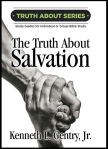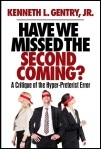“FLESH AND BLOOD CANNOT INHERIT THE KINGDOM OF GOD”?
PMW 2025-057 by Kenneth L. Gentry, Jr.
Introduction
We are currently witnessing the arising of neo-Gnosticism among a small but vocal body of some Bible students who are operating within evangelical Christian circles. This Gnosticism is making its presence felt by the ever evolving and continually splintering hyper-preterist movement. Though ancient Gnosticism was multi-faceted, at its core it elevated the spiritual realm over the physical. For those who are Gnostically-inclined today, salvation ultimately involves escape from the material realm and the physical body, preferring entry into the purely spiritual realm in a new ethereal body, such as proposed long ago by Origen.
The label of “neo-Gnosticism” can easily apply to hyper-preterism. This is (partly) due to its denial of a future, physical, fleshly resurrection of the dead. Some hyper-preterists go so far with this neo-Gnostic preference as to even rework Christology itself. They claim that though Jesus was physically resurrected from the dead, his physical body of flesh and bone dissipated and was replaced by an ethereal body made of spirit. This occurred in conjunction with his ascension.
Incarnation and Redemption
Consequently, this heresy denies the permanent incarnation of Christ, whereby God “became flesh” (John 1:14; cp. Gal. 4:4; Heb. 2:17). Thus, it rejects the biblical doctrine of the permanent, ongoing incarnation, reducing it to just a brief episode of thirty or so years for the Son of God. As Gerritt S. Dawson puts it:
“The incarnation was not a lightning strike that is brilliant one moment but gone the next. No — though he is in heaven, he remains one of us, wearing the clothes of flesh he acquired on earth, even into eternity.”
And it therefore undermines the historic Christian doctrine of the hypostatic union of Christ. This biblical doctrine teaches the permanent union of two natures (one fully divine and the other fully human) in the one Person of Christ. The hypostatic union is redemptively necessary for our full and final redemption in that man was created as a body-and-soul composite (Gen. 2:7) and will be judged as a body-and-soul unit (Matt. 10:28). Full salvation involves the full person which is denied in full preterism.
Contemporary neo-Gnostics within the various hyper-preterist movements deny the continuing physical nature of the resurrected body of Christ despite the biblical evidence. Eyewitnesses saw him as the resurrected Lord bodily ascend into heaven (Acts 1:9–10; cp. Mark 16:19; Luke 24:50–51). In fact, the angel speaks of the ascending Jesus as “this Jesus” (Acts 1:11) with whom they had just been talking (v. 9). And the ascension was witnessed by the disciples after receiving forty days of “convincing proofs” (Acts 1:3) of the physical nature of his resurrection (Luke 24:39–43; John 20:25, 27).
 The Truth about Salvation By Ken Gentry
The Truth about Salvation By Ken Gentry
A study guide for personal or small group Bible study. Deals with the Christian doctrine of salvation from a Reformed theological perspective. It opens with a study of God as loving Creator, the shows how the first man fell into sin. Shows God’s righteousness requires that sin be dealt with. Presents Jesus as both God and man so that he can be man’s Savior. Includes review questions and questions for further study.Twelve chapters are ideal for one quarter of Sunday School.
See more study materials at: www.KennethGentry.com
Jesus’ Physical Resurrection
Indeed, the New Testament provides abundant evidence for Jesus’ physical, bodily resurrection from the dead. We can see this evidence in Scripture on at least fourteen occasions and by various persons. He was either visibly seen (by man) or authoritatively declared (by angels) to be raised from the dead as we see from the following:
• The angel(s) declared him as risen from the dead at the empty tomb (Matt. 28:5–6; Mark 16:5–6)
• Mary Magdalene saw him (Mark 16:9; John 20:14)
• Several unnamed women saw him (Mark 16:1–8; Matt. 28:9–10; Luke 24:1–11)
• Two disciples on the Emmaus road saw him (Mark 16:12–13; Luke 24:13–35)
• Ten of Jesus’ original disciples in the upper room saw him (Luke 24:36–43; John 20:19–23)
• The eleven disciples (after Judas’ death) a week later saw him (Mark 16:14–18; John 20:24–29)
• Cephas (Peter) saw him (1 Cor. 15:5), and later preached on his resurrection in a body that did not suffer decay (Acts 2:25-32)
• James, the brother of Jesus, saw him (1 Cor. 15:7)
• The eleven disciples in Galilee saw him (Matt. 28:16–20)
• Seven disciples in Galilee saw him (John 21:1–14)
• The eleven disciples on the Mount of Olives saw him (Luke 24:44–53)
• 500 believers at the same time saw him (1 Cor. 15:6).
• The Apostle Paul saw him (Acts 9:1–9)
• The two angel(s) at the ascension declared him raised from the dead (Acts 1:10–11)
The Continuing Incarnation
In addition, this denial of the Lord’s continuing incarnation contradicts direct statements made in various places in Scripture. For example, consider just five examples (one of which I have already mentioned):
Colossians 2:9: “For in Him all the fullness of Deity dwells [katoikei, present tense] in bodily form.”
1 Timothy 2:5: “For there is one God, and one mediator also between God and men, the man Christ Jesus.”
1 Corinthians 15:4: “He was buried, and that He was raised on the third day. (“He was raised” is the perfect, passive of egeiro: egegertai, which means “he was and continues to be raised.”)
Acts 1:9-11 serves as a double witness to his continuing incarnation, for it speaks of his bodily ascension into heaven as well as his bodily return at the second advent: “And after He had said these things, He was lifted up while they were looking on, and a cloud received Him out of their sight. And as they were gazing intently into the sky while He was going, behold, two men in white clothing stood beside them. They also said, ‘Men of Galilee, why do you stand looking into the sky? This Jesus, who has been taken up from you into heaven, will come in just the same way as you have watched Him go into heaven.’” (Many other verses could be brought to bear on both of these concepts of ascension and return.)
The incarnation was a permanent addition taken on by the Son of God when he became flesh as the Son of Man (his favorite self-designation, which still applies even to him now in heaven, Acts 7:56; Rev. 1:13; 14:14). By his incarnation he is forever united with us as the God-man. He came to earth to take on a physical body (John 1:14; Heb. 2:14; 10:5), was crucified and died in his physical body (Matt. 27:32–56; Luke 23:34–45), and was resurrected in his physical body (Luke 24:39–43; John 20:25, 27; Rom. 8:11). These truths lie at the very core of the Christian faith as revealed in Scripture.

Blessed Is He Who Reads: A Primer on the Book of Revelation
By Larry E. Ball
A basic survey of Revelation from an orthodox, evangelical, and Reformed preterist perspective. Ball understands John to be focusing on the destruction of Jerusalem and the temple in AD 70. Insightful. Easy to read.
For more Christian studies see: www.KennethGentry.com
Then he ascended into heaven in his physical body (Mark 16:19; Luke 24:50–51; Acts 1:9–11; 2:33–36; Eph. 1:20; 3:20; 4:8–10; Col. 3:1; Heb. 1:3; 4:14; 10:12; 1 Pet. 3:22; cp. John 3:13; 6:62; 20:17). Consequently, he is there at God’s right hand currently interceding for us as the incarnate Son of God, our Mediator (Rom. 8:34; 1 Tim. 2:5; Heb. 2:17–18; 7:25; 1 John 2:1). Then at the end of history (1 Cor. 15:25–26; 1 Thess. 4:13–17) he will return in his physical body (Matt. 16:27; Acts 1:10–11; Phil. 3:20–21) so that he may conduct the final judgment as a true man, the incarnate God-man (Matt. 25:31–33; Acts 5:22, 27; 17:31). Indeed, the Father “gave Him authority to execute judgment, because He is the Son of Man” (John 5:27; cp. John 5:22; Acts 10:42). He will be the judge because he is and will continue to be a man (Acts 17:31). After this, he will establish the eternal, physical new earth where we will dwell forever in righteousness (2 Pet. 3:10–13; Rom. 8:22–23). [1]
As B. B. Warfield put it: “the glory of the Incarnation is that it presents to our adoring gaze, not a humanized God or a deified man, but a true God-man — who is all that God is and at the same time all that man is.” And Albert Barnes well observed that “almost all heresy has been begun by some form of the denial of the great central truth of incarnation of Son of God” (comment at Col. 2:9). Hyper-preterism’s reinterpretation of his incarnate state, reducing it to a temporary experience by Christ, at least borders on this heresy.
Rhetorical Structure of 1 Corinthians 15:50–53
In fact, the neo-Gnostics hold that 1 Corinthians 15:50 teaches that we cannot enter into the eternal bliss of the kingdom of God with fleshly bodies: “Now I say this, brethren, that flesh and blood cannot inherit the kingdom of God.” Therefore, our “resurrection” must involve the disposal of our old material body in which we lived on earth, whereupon God will replace it with an altogether new and different “spiritual body.” This is a tragic misreading of what Paul is teaching here — and throughout 1 Corinthians 15.
Have We Missed the Second Coming:
A Critique of the Hyper-preterist Error
by Ken Gentry
This book offers a brief introduction, summary, and critique of Hyper-preterism. Don’t let your church and Christian friends be blindfolded to this new error. To be forewarned is to be forearmed.
For more Christian educational materials: www.KennethGentry.com
It is important for us to recognize both the literary unit wherein we find verse 50, as well as its rhetorical point. As James Ware and others point out, 1 Corinthians 15:50–53 is a distinct literary unit in Paul’s argument against those who deny the idea of a resurrection (cf. vv. 12–19, 35–36a). And it is a well-crafted and highly structured rhetorical unit involving a concentric argument in an A-B-Aˈ pattern of synonymous parallelism. What is being argued herein?
As I will show more fully below, in (A) Paul points out a concerning, negative situation in the opening of the unit at verse 50. Here he presents a dangerous scenario for his proto-Gnostic opponents at Corinth. Then (Aˈ) he restates the matter, resolving the problem into a positive result at the end of the unit in verse 53. But in verses 51 and 52 (B) these opposing situations are connected chiastically by an important explanation. And in this explanation, verses 51–52 introduce the “mystery” of the change that will be effected at the resurrection and which will resolve the negative situation.
Let us first note how this is so, then consider the interpretive implications of Paul’s rhetorical argument. We will see how this supports the belief in our future physical, bodily resurrection as taught by the historic, corporate, public, universal, systematic Christian faith.
Schematic Analysis
As James Ware, John Gillman, Duane Watson, Margaret Mitchell, and others have shown, the A-B-Aˈ structure of the passage may be laid out schematically as follows, with bold type emphasizing the crucial features being linked:
A (v. 50): Now I say this, brethren,
a flesh and blood cannot inherit the kingdom of God;
b nor does the perishable inherit the imperishable.
B (vv. 51–52): Behold, I tell you a mystery;
c We will not all sleep, but we will all be changed;
d in a moment, in the twinkling of an eye, at the last trumpet;
dˈ for the trumpet will sound,
cˈ and the dead will be raised imperishable, and we will be changed.
Aˈ (v. 53) For [it is necessary that, Gk., dei gar]
bˈ this perishable must put on the imperishable,
aˈ and this mortal must put on immortality.
In the A statement (v. 50) we find the negative circumstance facing men: our current flesh and blood bodies cannot inherit (enter into, inhabit) the kingdom of God (i.e., the consummate eternal state of the redeemed in the presence of God). This is expressed by synonymous parallelism:
Flesh and blood > kingdom of God = perishable > imperishable
Similarly, Aˈ (v. 53) presents another synonymous parallelism:
perishable > imperishable = mortal > immortal
But in this case, the problem of A (v. 50) is solved by the situation presented in Aˈ (v. 53). For now the perishable and mortal put on imperishability and immortality. How can this be?
Paul explains this is the “mystery” (v. 51) [2] that allows flesh-and-blood men to enter into the glorious, consummate, eternal kingdom of God. He informs us in this transition passage (the center of the chiasm) that our perishable and mortal state will be changed by putting on the imperishable and immortal. This will occur at the resurrection on the last day, i.e., at the “last trumpet” (v. 52). [3]
So then, the “change” that will occur when “the dead will be raised” is that we will be clothed with (“put on”) imperishable, immortal bodies. We are not changed from flesh into spirit, for Paul states “for this perishable [body] must put on the imperishable, and this mortal [body] must put on immortality. But when this perishable [body] will have put on the imperishable, and this mortal will have put on immortality” (1 Cor. 15:54). This fleshly body laid in the dust is the same body of flesh that is to arise immortal.
[image error]For more information and to order click here.
" data-image-caption="" data-medium-file="https://postmillennialworldview.com/w..." data-large-file="https://postmillennialworldview.com/w..." class="alignright size-full wp-image-211" src="https://postmillennialworldview.com/w..." alt="" width="101" height="150" />Perilous Times: A Study in Eschatological Evil (by Ken Gentry)
Technical studies on Daniel’s Seventy Weeks, the great tribulation, Paul’s Man of Sin, and John’s Revelation.
See more study materials at: www.KennethGentry.com
We must recognize that this “change” comes by addition, not subtraction. It comes by our putting on a new quality, our adding to ourselves the glorious qualities of imperishability and immortality. We do not experience the subtraction of our physical nature. Our body will be raised miraculously by the almighty power of God as it is transformed from perishable to imperishable — not from physical to spiritual. For Jesus was the first fruits of the consummate resurrection (vv. 20, 23), and as noted above (and throughout the New Testament and Christian history), he was raised physically from the dead.
Thus, here in verses 50–53 the opening of the A stem (v. 50) speaks (“I say this”) to this issue, matching the opening of the Aˈ stem that declares “it must” be so. Here man’s predicament is introduced in the A stem negatively, warning that flesh and blood cannot inherit the kingdom, nor can the perishable inherit the imperishable. What then can be done? Again verse 53 answers that “this perishable must put on the imperishable, and this mortal must put on immortality.” Thus, the resurrection adds something (puts on imperishability, like clothing), rather than subtracting something (removing the physical body). And this is due to the mystery of the resurrection-change (vv. 51–52). The passage does not mention changing substance (flesh to spirit) but changing quality (mortal to immortal).
Notes
1. By the way, I know the maneuvers that the hyper-preterists have developed to re-interpret these passages to fit their scheme. Similarly, I also know the way that Jehovah’s Witnesses re-interpret verses that teach the deity of Christ and the Trinitarian nature of God. Any passage of Scripture can be taken outside the bounds of the Christian faith and re-worked to mean something altogether different. Sad, but true. As Peter warns, “the untaught and unstable distort … Scriptures to their own destruction” (2 Pet. 3:16).
2. In the New Testament, a “mystery” is something which requires a divine revelation from God in order to know or understand it.
3. As an important aside, note that we do not enter this new immortal, resurrected state at the moment of our death (as per DeMar and some other hyper-preterists), but at the “last trumpet” and as a corporate (simultaneous) action).
Openness Unhindered (by Rosaria Butterfield)
Dr. Butterfield goes to great lengths to clarify some of today’s key controversies. She also traces their history and defines the terms that have become second nature today-even going back to God’s original design for marriage and sexuality as found in the Bible. She cuts to the heart of the problems and points the way to the solution.
See more study materials at: www.KennethGentry.com
Kenneth L. Gentry Jr.'s Blog
- Kenneth L. Gentry Jr.'s profile
- 85 followers



